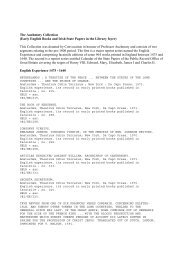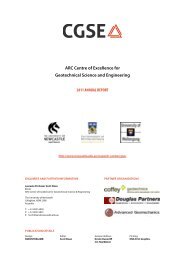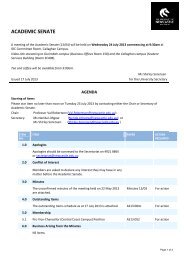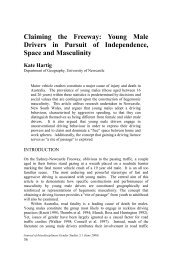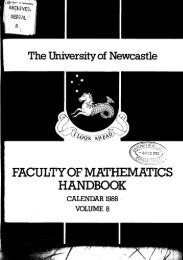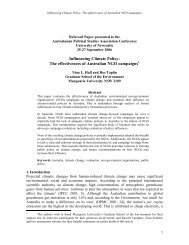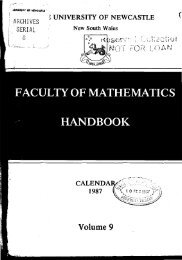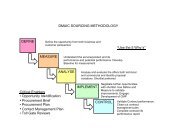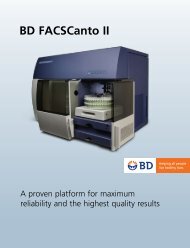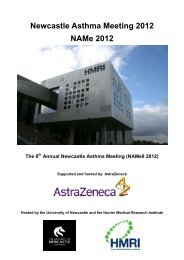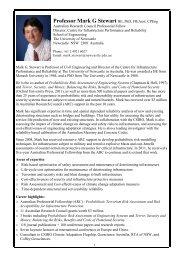n - University of Newcastle
n - University of Newcastle
n - University of Newcastle
Create successful ePaper yourself
Turn your PDF publications into a flip-book with our unique Google optimized e-Paper software.
Gu clj ir, ' and'; nlinnig, ' if '; ka, ' or.' There is no ~oorcl for<br />
' mhea,' but minnig and ka are usecl in its stead ; for instance,<br />
' whe~i I see you to-morrow' vill be expressecl by 'if I see yo11<br />
to-morrow'; ancl ' when dicl you come to Perth '2 -.ill be ' clicl you<br />
come to Perth to-day or yesterday '2 9. INTEEJECTIOSS.<br />
Nah-ah ! so ! (to illclicate that a person is listening to what is<br />
relateel), ancl n'y dn-' alas '!<br />
OF THE ABOEIGIYAL DIALECT CALLED<br />
THE 'IITIRRADHURI.<br />
[The TTirradhnri dialect, or, as I call it, the TTi~iclhari, covers the \%-hole<br />
heart <strong>of</strong> N. S. TTales ; its limits are shov-n on tlie map <strong>of</strong> the native tribes.<br />
I consider myself fortunate in having secured the publication <strong>of</strong> the<br />
Grammar ancl Vocabulary <strong>of</strong> so important a tnbe. The following manuscript<br />
1-i-as ~vritten about fifty years ago by the late Archdeacon Gunther,<br />
and is specially reliable becanse <strong>of</strong> its author's character ancl experience,<br />
and because, at that time, the tribe had not ~ ebegun t to decay, and its<br />
language was entire. He mas eclncated for the Ministry at Basle, in<br />
Switzerland, attending lectures there at tlie <strong>University</strong> and tile hlissionary<br />
College; snbsequently he prosecuted his studies at the C. 31. Society's<br />
College, Islington, London.<br />
In 1837, he commenced his illissionary work anlono the aborigines <strong>of</strong> the<br />
TT7irkdhsri tribe at " TVellington Valley," now TYellLgton, in New Soutli<br />
Wales. Here lie compiled th~s Grammar and Vocabulary ; he also trans-<br />
! latecl the Gospel by 81 Luke and portions <strong>of</strong> the Prayer Book for the use<br />
3 <strong>of</strong> the tribes on the hiacquarie River and the neighbouring country. His<br />
efforts and those <strong>of</strong> the mission party, in ameliorating the conclition <strong>of</strong> the<br />
natives and teaching them, met with considerable success. After the<br />
mission was ahancloned by the authorities, lie was induced by Bishop<br />
Broughton to accept the parish <strong>of</strong> $luclgee, where he laboured for Illany<br />
years, and clied in December. 1879.<br />
These MSS. are the property <strong>of</strong> the late Mr. Ghnther's son, the present<br />
Archcleacon <strong>of</strong> Camden, New Sonth Wales, who has kindly lent them to<br />
ine for this purpose. In ecliting them, I have retained the author's mode<br />
<strong>of</strong> spelling the native words, and have made only some slight alterations in<br />
the forin <strong>of</strong> the matter <strong>of</strong> the Grammar and the Vocabulary, with the view<br />
<strong>of</strong> securing greater symmetry throughout.-ED.]<br />
THE W1BADI)YAEI DIALECT.<br />
1. THE G-EA313IAE.<br />
--<br />
1. THE DECLESSION OF NOUSS.<br />
There is, properly speaking, only oue primary declension, but the<br />
principle <strong>of</strong> assimilation, to which the language llas a strong<br />
tenclency, sometimes produces slight rariat,iolls <strong>of</strong> the termi~lations<br />
<strong>of</strong> the nouns before the case-endings ; similarly, ~-;11en the<br />
last letter but one <strong>of</strong> tlre sten1 is i.<br />
In order to cover dl these variations, the nul~lber <strong>of</strong> the cleclensions<br />
will arno~~nt to eight. It must, however, be observed<br />
that here tlie formation <strong>of</strong> cases diffsrs lnaterially from the modes<br />
usecl in other languages, at. least fronl that <strong>of</strong> the Latin ancl<br />
r e . The. simple or nomimatire form unclergoes no alterat,ion,<br />
but, to form the cases, it takes aclclitiolls by means <strong>of</strong> postfixes.<br />
The only appareilt exception to this rule is that ~vliere the letter<br />
i is cast out. The number <strong>of</strong> cases cannot easily be fixed, since<br />
almost erery relation in wliicli a noun may be placed is signified<br />
by some postfix or other ; those $:-en in the examples below include<br />
the most colnmoll and essential relations.<br />
A strange peculiarity <strong>of</strong> this language is the existence <strong>of</strong> two<br />
nominative-forms-the one the sin~ple szontinnt.ive or nominatiredeclarative,<br />
corresponrling to the questioll ' 7~110 ov what is it '2<br />
and t,he other the szonzinntive active, when tl~e thing or person<br />
spoken <strong>of</strong> is considerecl as an agent; this ansx\-ers to the question,<br />
' 1%-ho or n~hat cloes it '? The genitice ancl the dc6tiz.e are alike ;<br />
the acczcsntive is the same as the simple ilominative ; tlle vocative<br />
is l;no\~n by the exclamatory worcl '7%' put before the simple<br />
nominative, or by its termination, which is like that <strong>of</strong> the genitive.<br />
The cnse-endings anel their meanings nlay be sllomn thus :-<br />
Case. Tern~inations. AIeaning.<br />
1. il'oi:~incttiae the simple form.<br />
2. A'ont. C L ~ E ~ Z ~ . -c1~1, -clyu? -p, lu, the agent form.<br />
3. Genitive -gn . ' <strong>of</strong> '; ' belonging to.'<br />
4. Batice -RU ' to,' for,' 'to\~lrds.'<br />
5. Accusntivc the same as stom. 1. the direct object.<br />
6. Focc~tiue prefixes ya to nou~. 1.<br />
7. Loconaotive -clyi, -li, -ri place from vhich.<br />
S. Conjzcncti~ve -clurai or -durei ' t<strong>of</strong>iet,her mi~;li.'<br />
9. Locntize -cia, -clya, -ya, -la, -ra 'in,' ' on,' 'at.'<br />
10. Instrun~ental -durada 'by means <strong>of</strong>.'<br />
The numbering <strong>of</strong> the cases corresponds nith that sllo-\m on the Paradigm.<br />
The same word is both singular aucl plural without cha~lge ;<br />
only when the iclea <strong>of</strong> plurality is to be conveyecl, tlle nom1 adds<br />
the word ga 1 a g and is then cleclinecl like IT- a 11 a g <strong>of</strong> the paradigm.



